Here’s today’s AdExchanger.com news round-up… Want it by email? Sign up here.
Disconnecticut
Connecticut has become the fifth state to pass a data privacy law.
The Connecticut Data Privacy Act (CTDPA), effective July 2023, follows in the footsteps of California, Colorado, Virginia and Utah in setting statewide safety rails around consumer data collection.
Like its predecessors, the CTDPA will limit data collection to what’s “reasonably necessary” in order to conduct a service, and require businesses to obtain informed consent before collecting personal data.
But there are still holes when it comes to children’s data. The law bans targeted advertising to children when a company has “actual knowledge” that the child is between 13 and 15 years old. Meanwhile, privacy advocates have been decrying the knowledge exception enshrined in the now 24-year-old Children’s Online Privacy Protection Act (COPPA) for years.
Under COPPA, it’s all too easy for businesses to claim ignorance of their audience’s age, even when that knowledge should be obvious.
As more states sign privacy bills into law, that issue will be pushed up to the federal level. And speaking of the federal level, can we expect a federal privacy law at some point soon? It’s hard to say, but one thing is certain: Connecticut won’t be the last state to pass its own privacy regs.
Tik … Tok … Boom
TikTok cleared an eye-popping new benchmark, according to eMarketer, which now forecasts that sometime this year TikTok will pass YouTube as the social media leader in time spent per user.
TikTok shot past Facebook and Instagram in 2020 – the Meta-owned apps see users spend an average of between 34 and 38 minutes per day, respectively – and is now above three hours per day.
That means TikTok is nipping at YouTube’s heels, which is an even more shocking accomplishment when you consider TikTok is made up of mostly seconds-long videos and YouTube has lots of long-form content.
TikTok’s consumer app growth is crazy. But its ad platform business is a hatchling compared to full-grown eagles like YouTube and Meta. TikTok is growing up fast, though.
EMarketer now predicts that TikTok’s US ad revenue will surpass YouTube sometime in 2024 – which is actually a conservative estimate. TikTok’s US business made $2.1 billion overall last year, per eMarketer’s data, and is expected to reach almost $6 billion in 2022 – a $3.9 billion year-over-year addition. In 2023, the forecast is for $8.8 billion, followed by $11 billion in 2024.
Pay Attention
Connected TV audiences are thought of as multi-device multitaskers. While your ad’s playing, they’re checking their phone.
But CTV viewers actually pay closer attention than their linear and social video counterparts, per a survey by the European video ad platform ShowHeroes, which used eye-tracking tests and special glasses it distributed to respondents.
According to the study, the length of time users watched CTV ad breaks before looking away was five times longer than YouTube ads (lol) and three seconds longer than linear commercials, Campaign reports. The research pinned CTV’s overall attention score at 82%, compared with 69% for linear and 42% for social video.
CTV is inherently more interactive than linear – and has nearly half the ad load, ShowHeroes CEO Ilhan Zengin tells AdExchanger. After all, usually people actively choose to watch something on a streaming service, whereas, on linear TV, viewers often default to watching whatever happens to be on.
Could be why 43% of participants in the study said they searched for a product promoted in a CTV ad – and why 20% of those reportedly made a subsequent purchase.
But Wait, There’s More!
With its Audience product, is Shopify creating a “Content-Fortress-as-a-Service”? [Mobile Dev Memo]
Cable’s last laugh. [Stratechery]
Google Assistant – now led by Sissie Hsiao, former GM of Google’s ad tech products – is reimagining itself. [Wired]
Chicken Soup for the Soul Entertainment (you heard me) acquires Redbox, known for its mall and grocery video kiosks. But it’s got a FAST channel, too. [release]
DuckDuckGo adds a feature to block Google Topics and FLEDGE. [MediaPost]
Prebid.org rolls out a new tool called Professor Prebid to troubleshoot header-bidding issues. [release]
Mike Shields: YouTube’s ongoing efforts to break into the TV conversation. [blog]
You’re Hired!
Brand consultancy Bounteous hires Jon Reily to lead its commerce practice strategy. [release]
AdTonos makes iHeartMedia vet Tony Moustakelis its US business development director. [release]













